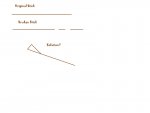SillyCowCorner1
Well-known member
A comment on the video by
A puzzle-solving competition for kids sounds like something that Ferrari would have done to solve the quartic equation back in the day. And this:James Smith said:The thing about these "less than a minute" problems is that it all comes down to how quickly you see how to solve the problem. I'd bet that the kids who solved this problem in under a minute had been working with geometry of shapes and were very familiar with this sort of problem.
From The History of Mathematics by BurtonFiore, believing Tartaglia’s claim to be a bluff, challenged him
to a public problem-solving contest. Each contestant was to propose 30 problems, the
victor being the one who could solve the greatest number within 50 days. Tartaglia was
aware that his rival had inherited the solution of some form of cubic equation from a
deceased master, and he worked frantically to find the general procedure. Shortly before
the appointed date, he devised a scheme for solving cubics that lacked the second-degree
term. Thus, Tartaglia entered the competition prepared to handle two types of cubics,
whereas his opponent was equipped for but one. Within two hours, Tartaglia had reduced
all 30 problems posed to him to particular cases of the equation x^3 + px = q, for which
he knew the answer.




